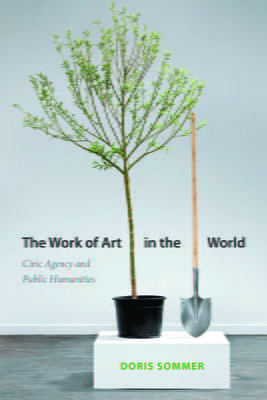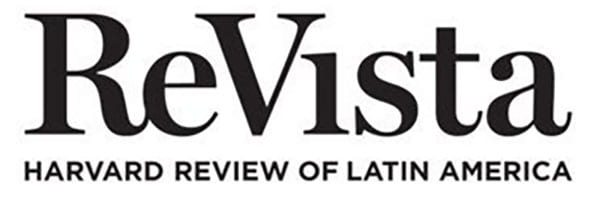A Review of The Work of Art in the World: Civic Agency and Public Humanities
Art as Civic Acupuncture
by Pedro Reina-Pérez

The Work of Art in the World: Civic Agency and Public Humanities By Doris Sommer Duke University Press, 2014
When Doris Sommer briefed Harvard President Larry Summers in 2006 on her Cultural Agents Initiative (CAI) at Harvard, she expressed concern about the deteriorating state of the humanities on campus—too little attention was given to art and interpretation as a way of approaching complex social problems. Artists, she argued, “help translate good ideas into enduring practices.” Yet humanistic programs such as the Cultural Agents Initiative were not afforded the same pragmatic consideration as economics or medicine, either by students seeking a vocation or by the university. This required a new way of thinking. President Summers stepped down from his post not long after this encounter, but Doris Sommer is still going strong in her quest to prove with philosophical and empirical data that the humanities are indispensable as a means to foster critical thinking, innovation and better civic practices.
The Work of Art in the World: Civic Agency and Public Humanities is the culmination of more than a decade of intellectual inquiry by Sommer, the Ira Jewel Williams Jr. Professor of Romance Languages and Literatures at Harvard University. Drawing from collaborations with scholars, artists and practitioners to build a theoretical foundation for the constitution of cultural agency, she argues for the relevance of engaged art to democracy.
Humanistic training, in Sommer’s words, teaches the skills—context, technique, messages and aesthetics—required for the interpretation of art and the development of disinterested judgment. The first three skills are regularly developed by scholarly means, but aesthetics holds greater potential to train judgment because “deciding if something is beautiful requires responding to an intense experience but obeying no established principles, and this decision is therefore free from prejudice. Aesthetic judgment is an exercise in unbiased evaluation, a knack that science and civics need as much as art does. That is why humanistic training is a fundamental contribution to general research and to social development.”
Sommer’s take on aesthetics is grounded in a careful selection of philosophical texts, beginning with Kant’s Third Critique of Reason (1709), which supplements the objective track of reason by introducing an opportunity for judgment. “Withdrawing from reason to judge the sensible and sentimental world of particulars,” writes Kant, “saves human beings from the excess of rule-driven behavior.”
Kant’s work is followed by Friedrich Schiller’s Letters on the Aesthetic Education of Man (1794), in which he argued in the midst of the French Revolution that the universal cultivation of judgment in art was fundamental to political freedom because art captures and extends the experience of beauty. Where nature can become habitual, art offers the possibility of surprise. Sommer also uses readings from modern thinkers ranging from Hannah Arendt to John Dewey to Paulo Freire to argue that making art (and thus interpreting it) is constitutive for human beings, and as such offers moments of “freedom unbound from content or rules.” The implications for the improvement of democracy and civic life, derived from this panoply of thinkers, are clearly rendered.
Central to the inspiration of Sommer’s work has been her association with Antanas Mockus, the former Bogotá mayor, who implemented innovative cultural projects to address social challenges and improve civic life in Colombia’s capital city between 1995 and 2003. Mockus sought to develop new paths through art to engage citizens in the formulation of systemic solutions to recurring problems. He put mimes at street intersections to mock traffic infractions, held symbolic vaccination campaigns to innoculate people from domestic aggression, and donned superhero costumes to walk around the city promoting civic values. His policy methodology was grounded in a solid theoretical and practical framework that allowed results to be measured, while persuading citizens to be active participants in the creative quest for answers. “One important lesson we learn from Mockus is that without pleasure, social reform and political pragmatism shrivel into short-lived, self-defeating pretensions,” Sommer writes. Sommer examines other initiatives in Latin America such as Augusto Boal’s Theatre of the Oppressed and Pedro Reyes’ Guns into Shovels art exhibit, among others, to illustrate how playful citizen complicity can produce meaningful and lasting effects.
At Harvard, she has taught the course Aesthetic and Interpretive Understanding that served as a laboratory of sorts to refine her own thought on creative social interventions, while persuading students to embark on their own quest for action and meaning. In this regard, the book is both scholarly and personal, combining her readings of major works with her own thoughts and practical experiences. The author’s voice is didactic and compelling, crafting an impassioned argument for art as an agent for change.
The text is intimately linked to two of her works: Bilingual Aesthetics: A New Sentimental Education (Duke, 2004) and Cultural Agency in the Americas (Duke, 2006). In the first, she invites bilingual readers to play games with languages as a metaphor to explore new ways of civic thinking. She calls on citizens to explore and cultivate differences— the building blocks of democracy. The second book, an edited volume, traces the connection between creativity and social change in Latin America, focused on model cases presented by an outstanding group of scholars and practitioners. Thus, The Work of Art in the World culminates what the author began in 2004 to revisit creativity, art and thought and to engage in civic exploration, giving democracy a new realm of possibilities.
Collaboration between policy makers and artists is at the center of any effective cultural agency, but the author recognizes that partnerships of this kind may be unconventional. The former normally seek measurable results while the latter will defend art for its own sake. “The discord between pragmatics and aesthetics is doubly debilitating since the ‘adjacent possible’ counts on a combination or art and science. Development needs the imagination and judgment that the arts cultivate; and the arts thrive on adaptive challenges that throw systems into crisis and require new forms. Tracking hybrid creations means stepping beyond established practices and linking onto creative experiments. I want to encourage interpretation to take risks, to learn a lesson from art-making about getting one’s hands dirty through trial and error.”
The book will speak to readers on many levels. Scholars will ponder its philosophical arguments crafted with passion and wit, while artists inclined to social engagement will interpret its urgent call to expand the dialogue about art and political freedom. Sommer achieves a remarkable feat: to surprise artists and citizens anew into being co-creators of new paths to promote beauty and action. No small thing in these trying times.
Pedro Reina Pérez, a historian, journalist and blogger specializing in contemporary Spanish Caribbean history, was the 2013-14 DRCLAS Wilbur Marvin Visiting Scholar. He is a professor of Humanities and Cultural Agency and Administration at the University of Puerto Rico. Among his books and edited volumes are Poeta del Paisaje (2013), El Arco Prodigioso (2009) and La Semilla Que Sembramos (2003).
Related Articles
A Review of Bodies Found in Various Places
This bilingual anthology of Elvira Hernández, translated by Daniel Borzutzky and Alec Schumacher and published by Cardboard House Press, offers a comprehensive entry point into the work of the Chilean poet. The translators’ preface offers a valuable introduction that provides important context to her work and explains aspects of her poetry present in the volume, such as Hernández’s self-effacing “ethics of invisibility,” an ars poetica in which the poems stand in front while the poet hangs back, in a call to observe rather than to be observed. In this sense, Hernández has long written from the edges of Chile’s public life, partly by choice, partly by necessity: her birth name is Rosa María Teresa Adriasola Olave, but she adopted the pseudonym of Elvira Hernández under the Pinochet dictatorship.
A Review of An Ordinary Landscape of Violence
When first reading the title, An Ordinary Landscape of Violence, I asked myself if there is really anything “ordinary” about a landscape of violence? Preity R. Kumar argues that violence is endemic to Guyana’s colonial history and is something that women loving women (WLW) contend with and resist in their personal and public lives.
A Review of Lula: A People’s President and the Fight for Brazil’s Future
André Pagliarini’s new book arrives at a timely moment. During the summer of 2025, when the book was released, the United States began engaging in deeper debates about Brazil’s political situation. This shift was tied to the U.S. government’s decision to impose 50% tariffs on Brazilian products—the highest level ever applied to another country, matched only by India. In a letter to President Lula, Donald Trump’s administration justified the measure by citing a trade deficit with Brazil. It also criticized the South American nation for prosecuting one of Washington’s ideological allies, former president Jair Bolsonaro, on charges of attempting a coup d’état. Sentenced by Brazil’s Supreme Court to just over 27 years in prison, the right-wing leader had lost his 2022 reelection bid to a well-known leftist figure, Lula da Silva, and now stands, for many, as a global example of how a democracy can respond to those who attack it and attempt to cling to power through force.




